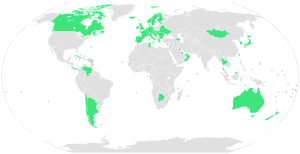Healthcare in Europe

Most European countries have universal health coverage.
>90% health insurance coverage, and
>90% skilled birth attendance.

Healthcare in Europe is provided through a wide range of different systems run at the national level. The systems are primarily publicly funded through taxation (universal health care). Private funding may represent personal contributions towards meeting the non-taxpayer refunded portion of costs or may reflect totally private (non-subsidized) healthcare either paid out of pocket or met by some form of personal or employer funded insurance. All EU and many other European countries offer their citizens a European Health Insurance Card which, on a reciprocal basis, provides insurance for emergency medical treatment insurance when visiting other participating European countries.
The European Union has no major administrative responsibility in the field of healthcare. The European Commission's Directorate-General for Health and Consumers however seeks to align national laws on the safety of food and other products, on consumers' rights and on the protection of people's health, to form new EU wide laws and thus strengthen its internal markets.
Healthcare Rankings
The 2014 Euro health consumer index, produced by Health Consumer Powerhouse, included 37 countries measured by 48 indicators.
| Country | Overall ranking | Patient rights and information ranking | Accessibility (waiting times for treatment) ranking | Outcomes ranking | Range and reach of services provided | Prevention | Pharmaceuticals |
|---|---|---|---|---|---|---|---|
| | 1 | 1 | 7 | 1 | 1 | 13 | 1 |
| | 2 | 12 | 1 | 3 | 14 | 6 | 9 |
| | 3 | 22 | 22 | 1 | 3 | 1 | 7 |
| | 4 | 6 | 10 | 6 | 4 | 6 | 1 |
| | 5 | 2 | 4 | 9 | 6 | 13 | 9 |
| | 6 | 22 | 1 | 9 | 4 | 19 | 9 |
| | 7 | 4 | 14 | 3 | 9 | 1 | 21 |
| | 8 | 17 | 7 | 6 | 6 | 5 | 16 |
| | 9 | 10 | 7 | 3 | 21 | 6 | 1 |
| | 10 | 9 | 4 | 16 | 11 | 19 | 9 |
| | 11 | 12 | 10 | 9 | 14 | 13 | 13 |
| | 12 | 12 | 35 | 6 | 1 | 1 | 7 |
| | 13 | 6 | 14 | 14 | 21 | 19 | 19 |
| | 14 | 8 | 30 | 16 | 6 | 6 | 1 |
| | 15 | 22 | 10 | 16 | 11 | 26 | 13 |
| | 16 | 17 | 25 | 16 | 9 | 13 | 1 |
| | 17 | 4 | 3 | 33 | 21 | 6 | 21 |
| | 18 | 10 | 19 | 16 | 11 | 36 | 21 |
| | 19 | 24 | 30 | 14 | 14 | 1 | 16 |
| | 20 | 24 | 27 | 9 | 18 | 13 | 16 |
| | 21 | 15 | 10 | 25 | 24 | 19 | 13 |
| | 22 | 19 | 22 | 22 | 24 | 6 | 21 |
| | 23 | 30 | 35 | 9 | 19 | 13 | 1 |
| | 24 | 19 | 14 | 23 | 19 | 34 | 21 |
| | 25 | 30 | 19 | 16 | 30 | 26 | 19 |
| | 26 | 24 | 14 | 30 | 24 | 19 | 21 |
| | 27 | 15 | 19 | 26 | 28 | 26 | 28 |
| | 28 | 29 | 25 | 30 | 14 | 6 | 33 |
| | 29 | 36 | 22 | 23 | 31 | 19 | 21 |
| | 30 | 34 | 14 | 26 | 35 | 26 | 28 |
| | 31 | 28 | 4 | 33 | 37 | 32 | 36 |
| | 32 | 24 | 30 | 33 | 24 | 26 | 28 |
| | 33 | 19 | 30 | 26 | 28 | 37 | 28 |
| | 34 | 30 | 27 | 36 | 31 | 25 | 33 |
| | 35 | 35 | 27 | 26 | 35 | 32 | 36 |
| | 36 | 30 | 30 | 36 | 34 | 26 | 28 |
| | 37 | 37 | 37 | 30 | 31 | 34 | 33 |
See also
References
- ↑ Stuckler, David; Feigl, Andrea B.; Basu, Sanjay; McKee, Martin (November 2010). "The political economy of universal health coverage. Background paper for the First Global Symposium on Health Systems Research, 16–19 November 2010, Montreaux, Switzerland" (PDF). Pacific Health Summit. Seattle: National Bureau of Asian Research. p. 16.
Figure 2. Global Prevalence of Universal Health Care in 2009; 58 countries: Andorra, Antigua, Argentina, Armenia, Australia, Austria, Azerbaijan, Bahrain, Belarus, Belgium, Bosnia and Herzegovina, Botswana, Brunei Darussalam, Bulgaria, Canada, Chile, Costa Rica, Croatia, Cuba, Cyprus, Czech Republic, Denmark, Estonia, Finland, France, Germany, Greece, Hungary, Iceland, Ireland, Israel, Italy, Japan, Kuwait, Luxembourg, Moldova, Mongolia, Netherlands, New Zealand, Norway, Oman, Panama, Portugal, Poland, Romania, Singapore, Slovakia, Slovenia, South Korea, Spain, Sweden, Switzerland, Taiwan, Thailand, Tunisia, UAE, Ukraine, United Kingdom, Venezuela.
- ↑ "Euro Health Consumer Index 2014". Health Consumer Powerhouse. Retrieved 31 January 2015.
- ↑ http://www.who.int/whr/2010/en/index.html The world health report - Health systems financing: the path to universal coverage http://whqlibdoc.who.int/whr/2010/9789241564021_eng.pdf